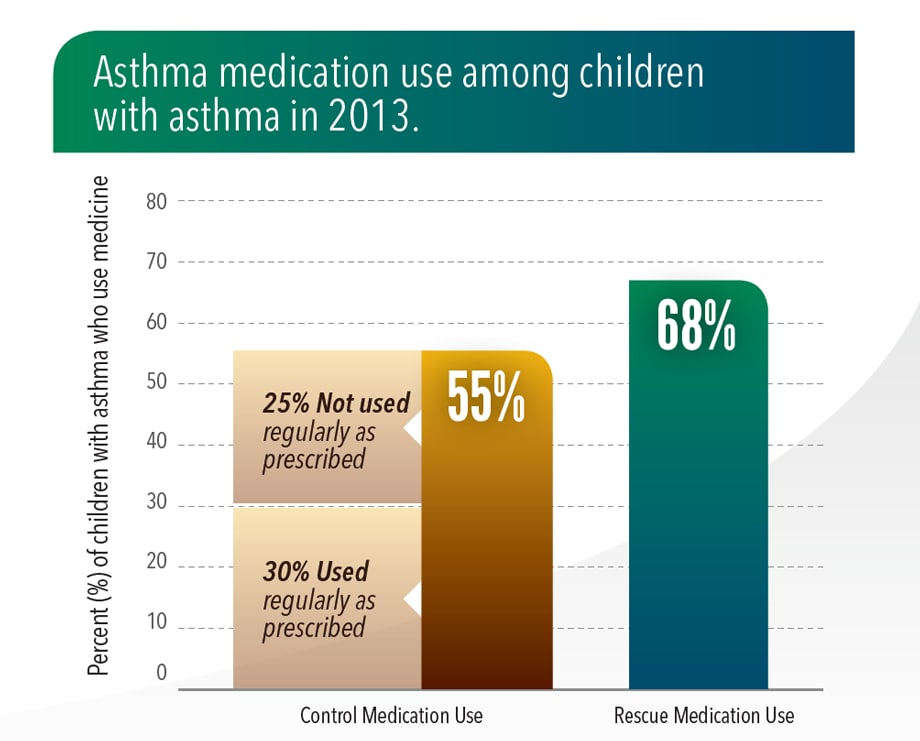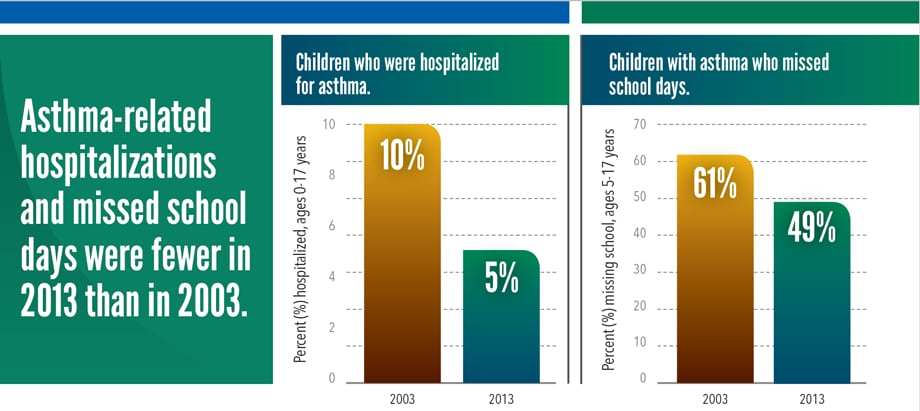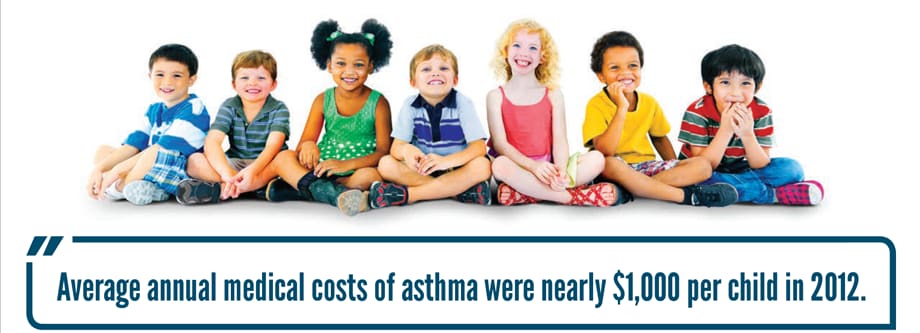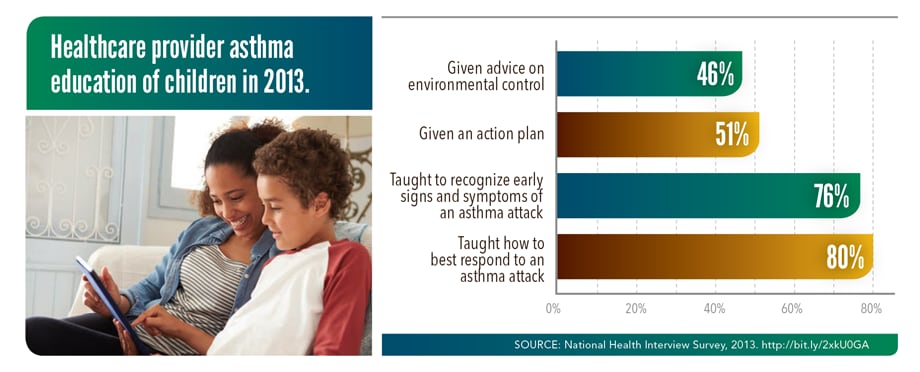Asthma in children
Working together to get it under control
Now available
- Free Continuing Education (CE) on Health Outcomes and Treatment for Childhood Asthma (MMWR/Medscape) – available until May 3, 2019.
Overview
Asthma is a serious disease causing wheezing, difficulty breathing, and coughing. Over a lifetime, it can cause permanent lung damage. About 16% of black children and 7% of white children have asthma. While we don’t know what causes asthma, we do know how to prevent asthma attacks or at least make them less severe. Today, children with asthma and their caregivers report fewer attacks, missed school days, and hospital visits. More children with asthma are learning to control their asthma using an asthma action plan.* Still, more than half of children with asthma had one or more attacks in 2016. Every year, 1 in 6 children with asthma visits the Emergency Department with about 1 in 20 children with asthma hospitalized for asthma.
Doctors, nurses, and other healthcare providers are:
- Teaching children and parents to manage asthma by using a personalized action plan shared with school staff and other caregivers. Such a plan helps children use medicine properly and avoid asthma triggers like tobacco smoke, pet dander, and air pollution.
- Working with community health workers, pharmacists, and others to ensure that children with asthma receive needed services.
- Working with children and parents to assess each child’s asthma, prescribe appropriate medicines, and determine whether home health visits would help prevent attacks.
* Asthma Action Plan, http://bit.ly/2scBt1W

Problem
Half of children with asthma had 1 or more attacks in 2016.
Asthma attacks: going down (but still too many).
- Attacks have gone down in children of all races and ethnicities from 2001 through 2016.
- About 50% of children with asthma had an attack in 2016.
- Asthma attacks occurred most frequently among children younger than age 5 in 2016.
- Emergency Department and urgent care center visits related to asthma attacks were highest among children ages 0-4 years and Non-Hispanic black children.
Using medicine as prescribed can prevent asthma attacks.
- Inhaled corticosteroids and other control medicines can prevent asthma attacks.
- Rescue inhalers or nebulizers can give quick relief of symptoms
- But . . . about half of children who are prescribed asthma control medicines do not use them regularly.

SOURCE: National Health Interview Survey, 2013. http://bit.ly/2xkU0GA

SOURCE: National Health Interview Survey, 2003 and 2013. http://bit.ly/2xkU0GA

SOURCE: http://bit.ly/2rtljBe

View large image and text description
What Can Be Done
The Federal government is
- Working with state, territorial, private and non-government partners to support medical management, asthma-self management education, and, for people at high risk, home visits to reduce triggers and help with asthma management. http://bit.ly/2y2XBgs, http://bit.ly/2hPeZ1l
- Providing guidelines, tools such as asthma action plans, and educational messages to help children, their caregivers, and healthcare professionals better manage asthma. http://bit.ly/2scBt1W
- Promoting policies and best practices to reduce exposure to indoor and outdoor asthma triggers such as tobacco smoke and air pollution.
- Tracking asthma rates and assuring efficient and effective use of resources invested in asthma services.
Doctors, nurses, and other healthcare providers are
- Teaching children and parents to manage asthma by using a personalized action plan shared with school staff and other caregivers. Such a plan helps children use medicine properly and avoid asthma triggers like tobacco smoke, pet dander, and air pollution.
- Working with community health workers, pharmacists, and others to ensure that children with asthma receive needed services.
- Working with children and parents to assess each child’s asthma, prescribe appropriate medicines, and determine whether home health visits would help prevent attacks.
Some payers/health insurance plans are
- Reimbursing healthcare providers for education of children with asthma, including development of their personalized asthma action plans.
- Providing training and incentives for health care providers to practice guidelines-based medical management.
- Taking actions to improve access to and proper use of asthma medications and devices.
- Providing each child with asthma with the medical and community-based services needed to control his or her asthma.
Parents and children are
- Learning about asthma, how to manage it, and how to recognize the warning signs of an asthma attack.
- Taking steps to reduce asthma triggers such as tobacco smoke, mold, and pet dander in the home. If caregivers smoke, they should try to quit or at least never smoke around children.
- Making sure children use their asthma controller medicine as prescribed.
- Communicating with schools, other family members, caregivers and healthcare providers about the child’s asthma action plan and about asthma symptoms.
Schools are
- Educating school nurses and other school staff about asthma and how to help children control it.
- Carrying out asthma-friendly policies to help children follow their action plans, including stocking quick relief medications, letting older children carry controller and rescue medicines, and helping children take part in school activities, such as exercising indoors when air quality is poor.
- Using CDC’s Strategies for Addressing Asthma in Schools. http://bit.ly/2wAtGcj





















.png)












No hay comentarios:
Publicar un comentario